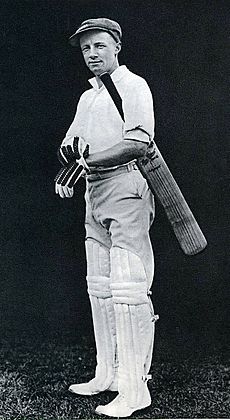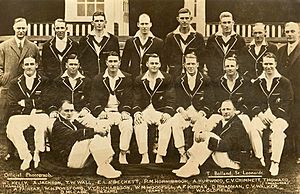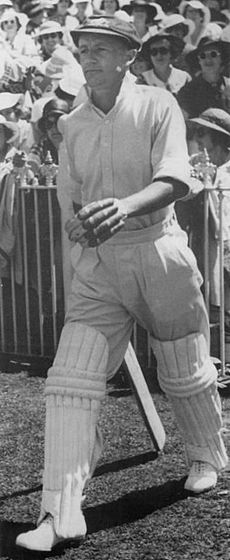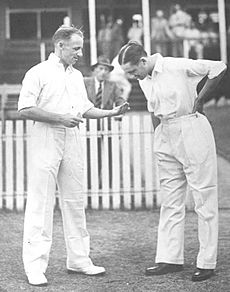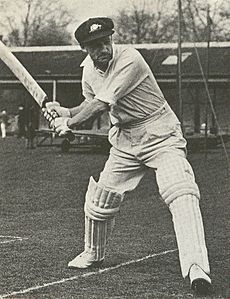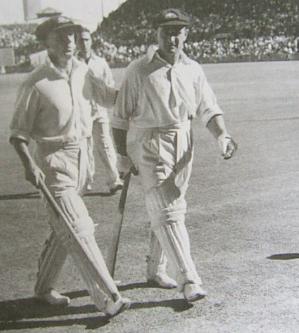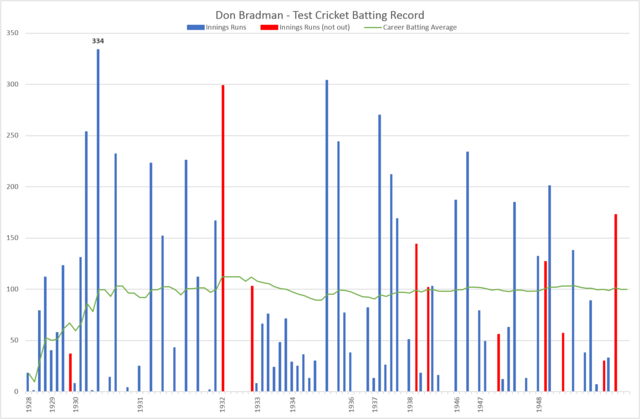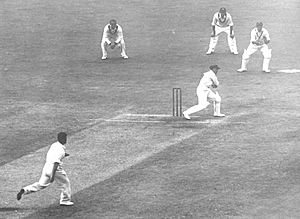Don Bradman facts for kids
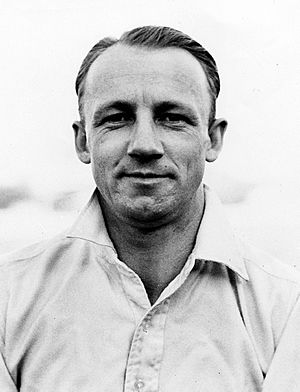
Bradman in 1930
|
||||||||||||||||||||||||||||||||||||||||
| Personal information | ||||||||||||||||||||||||||||||||||||||||
|---|---|---|---|---|---|---|---|---|---|---|---|---|---|---|---|---|---|---|---|---|---|---|---|---|---|---|---|---|---|---|---|---|---|---|---|---|---|---|---|---|
| Full name |
Donald George Bradman
|
|||||||||||||||||||||||||||||||||||||||
| Born | 27 August 1908 Cootamundra, New South Wales, Australia |
|||||||||||||||||||||||||||||||||||||||
| Died | 25 February 2001 (aged 92) Kensington Park, South Australia, Australia |
|||||||||||||||||||||||||||||||||||||||
| Nickname | The Don, The Boy from Bowral, Braddles, the White Headley | |||||||||||||||||||||||||||||||||||||||
| Height | 1.70 m (5 ft 7 in) | |||||||||||||||||||||||||||||||||||||||
| Batting | Right-handed | |||||||||||||||||||||||||||||||||||||||
| Bowling | Right-arm leg break | |||||||||||||||||||||||||||||||||||||||
| Role | Batsman | |||||||||||||||||||||||||||||||||||||||
| International information | ||||||||||||||||||||||||||||||||||||||||
| National side |
|
|||||||||||||||||||||||||||||||||||||||
| Test debut (cap 124) | 30 November 1928 v England | |||||||||||||||||||||||||||||||||||||||
| Last Test | 18 August 1948 v England | |||||||||||||||||||||||||||||||||||||||
| Domestic team information | ||||||||||||||||||||||||||||||||||||||||
| Years | Team | |||||||||||||||||||||||||||||||||||||||
| 1927/28–1933/34 | New South Wales | |||||||||||||||||||||||||||||||||||||||
| 1935/36–1948/49 | South Australia | |||||||||||||||||||||||||||||||||||||||
| Career statistics | ||||||||||||||||||||||||||||||||||||||||
|
||||||||||||||||||||||||||||||||||||||||
|
Source: ESPNcricinfo, 4 December 2014
|
||||||||||||||||||||||||||||||||||||||||
Sir Donald George Bradman (27 August 1908 – 25 February 2001), known as "The Don", was an Australian cricket player. Many people believe he was the greatest batsman of all time. His amazing Test batting average of 99.94 is considered one of the greatest achievements in any major sport.
The story goes that young Don Bradman practiced alone. He used a cricket stump as a bat and a golf ball. He would hit the ball against a curved brick stand. The ball would bounce back fast and at different angles. This practice helped him develop incredible timing and quick reactions. He rose from playing in the bush to the Australian Test team in just over two years. Before he turned 22, he had already set many scoring records. Some of these records still stand today. He became a national hero in Australia during the Great Depression.
During his 20-year career, Bradman scored so many runs that he was like "three batsmen to Australia." This was said by former Australian captain Bill Woodfull. England even created a special tactic called Bodyline to try and stop him. As a captain and leader, Bradman wanted cricket to be exciting and attacking. He attracted huge crowds. However, he didn't like being constantly praised, and this affected how he interacted with others. The huge focus on his individual scores sometimes caused problems with teammates and journalists. After a break because of World War II, he made an amazing comeback. He captained an Australian team called "The Invincibles". This team toured England without losing a single match.
Bradman was a very focused and driven person. He didn't have many close friends. After he retired from playing, he stayed involved in cricket for 30 years. He worked as an administrator, a selector, and a writer. Even when he became more private in his later years, people still wanted his opinion. He was still seen as a national hero. In 1997, almost 50 years after he stopped playing, Prime Minister John Howard called him the "greatest living Australian." Bradman's picture has been on stamps and coins. A museum about his life opened while he was still alive. In 2009, he was added to the ICC Cricket Hall of Fame.
Contents
Early Life and Cricket Beginnings

Donald George Bradman was born on 27 August 1908 in Cootamundra, New South Wales (NSW). He was the youngest of five children. His family moved to Bowral when he was about two years old. His mother, Emily, had played cricket herself.
Bradman spent a lot of time practicing his batting when he was young. He invented his own game using a cricket stump as a bat and a golf ball. He would hit the ball against a curved brick stand. The ball would bounce back quickly and at different angles. This helped him develop amazing timing and fast reactions. He scored his first century (100 runs) at age 12. He scored 115 runs for Bowral Public School.
Becoming a Bush Cricketer
In the 1920–21 season, Bradman started as a scorer for his local Bowral team. He filled in for a missing player and scored 37 and 29 runs in his first game. During this season, his father took him to the Sydney Cricket Ground (SCG). He watched an Ashes Test match there. Bradman decided then that he wanted to play on that ground. He left school in 1922 and worked for a real estate agent. This job allowed him time off for sports. He played tennis for two years but returned to cricket in 1925–26.
Bradman became a regular player for the Bowral team. His great performances caught the attention of Sydney newspapers. He played on matting-over-concrete pitches against other country towns. He scored 234 runs against Wingello. In the competition final against Moss Vale, he scored 320 runs without being out.
In 1926, the Australian team lost The Ashes in England. The New South Wales Cricket Association started looking for new players. They invited Bradman to a practice session in Sydney. He was chosen for "Country Week" tournaments in both cricket and tennis. His boss said he could only have one week off. Bradman chose cricket.
His performances during Country Week led to an invitation to play grade cricket in Sydney. He joined St George for the 1926–27 season. He scored 110 runs in his first game on a turf pitch. He traveled 130 km from Bowral to Sydney every Saturday to play.
First Big Games
The next season, Bradman's career took off even faster. He was chosen for the NSW team at age 19. He made his first-class debut at the Adelaide Oval. He scored 118 runs, showing his fast footwork and calm confidence. In the last match of the season, he scored his first century at the SCG. This was against Sheffield Shield champions Victoria.
Bradman moved to Sydney for the 1928–29 season. He knew that England would be touring. He scored a century in each innings against Queensland. He then scored 87 and 132 not out against the touring English team. This earned him a spot in the first Test match in Brisbane.
Test Career Highlights
Bradman's first Test match was tough. Australia was bowled out for only 66 runs in one innings. They lost by a huge margin. Bradman scored only 18 and 1 run. He was dropped for the next Test. But he was called back for the Third Test in Melbourne. He scored 79 and 112 runs. He became the youngest player to score a Test century. Australia still lost that match.
The Australians improved and won the Fifth Test. Bradman scored 123 runs. He finished the season with 1,690 first-class runs. He averaged 93.88 runs per innings. He also scored his first double century in a Sheffield Shield match. In 1929–30, Bradman set a world record for first-class cricket. He scored 452 runs without being out. He made these runs in just 415 minutes.
1930 Tour of England
England was expected to win the 1930 Ashes series. But Bradman started the tour with 236 runs in his first game. He then scored 1,000 first-class runs by the end of May. He was the first Australian to do this. In his first Test in England, Bradman scored 131 runs. In the Second Test at Lord's, he scored 254 runs. He later said this was his best innings ever.
In the Third Test at Headingley, Bradman scored a century before lunch. He is the only Test player to score over 300 runs in one day. His final score of 334 was a world record. He completely dominated the Australian innings. The match ended in a draw due to bad weather.
In the final Test at The Oval, Bradman scored another double century, 232 runs. This helped Australia win the match and regain the Ashes. English players noticed that Bradman struggled against fast, short balls. This observation would become very important in the next Ashes series.
Bradman's victory was huge in Australia. The country was in a depression, and people found hope in this sporting success. Bradman, a 22-year-old from the bush, became a national hero. He scored 974 runs in the Test series, averaging 139.14. This included four centuries, two of them double centuries, and one triple century. No one has scored more runs in a Test series since. He also scored 2,960 first-class runs on the tour. This was another record for an overseas batsman in England.
Off the field, Bradman was quiet and private. He didn't like the constant attention. This focus on his individual success sometimes caused problems with his teammates.
Facing Bodyline Tactics
England's cricket leaders decided they needed new tactics to stop Bradman. They appointed Douglas Jardine as captain for the 1932–33 tour to Australia. Jardine remembered Bradman struggling against short balls in 1930. He decided to use a tactic called Bodyline. This involved fast bowlers aiming short balls at the batsmen's bodies.
Bradman had other issues at this time, including illness. He also had a disagreement with the Australian Board of Control about writing a newspaper column. He threatened to stop playing cricket if he couldn't write. Eventually, the newspaper let him out of his contract. In warm-up games against England, Bradman didn't score many runs. He warned officials that Bodyline would cause trouble. He even missed the First Test due to illness. England used Bodyline and won the first match.
The public desperately wanted Bradman to return and beat Bodyline. He came back for the Second Test in Melbourne. A record crowd of 63,993 people watched. Bradman was bowled out for a duck on his first ball. The crowd was stunned. But Bradman then scored an unbeaten 103 runs in the second innings. Australia won the match.
The Third Test in Adelaide was very tense. Australian captain Bill Woodfull and wicket-keeper Bert Oldfield were hit by bouncers. Woodfull famously said, "there are two teams out there and only one of them is playing cricket." England continued with Bodyline. They won the last three Tests and regained the Ashes. Bradman scored 396 runs in the series, averaging 56.57. He tried new ways to score against Bodyline, often hitting the ball into empty parts of the field.
The constant attention and the tough season made Bradman rethink his life. He wanted a career away from cricket fame. He was offered a job as a stockbroker in Adelaide if he would move there and captain the South Australia team. He agreed to the move in February 1934.
Health Issues and Comeback
In his last season for NSW, Bradman averaged 132.44 runs. He was made vice-captain for the 1934 tour of England. However, he was often unwell during the tour. He went 13 innings without a century, his longest such period. Some thought Bodyline had affected his confidence.
In the Fourth Test at Headingley, Bradman scored 304 runs. He shared a world record partnership of 388 runs with Bill Ponsford. In the Fifth Test at The Oval, they broke their own record. They made an even bigger partnership of 451 runs. Bradman scored 244 runs. Australia won by a huge margin and regained the Ashes. England would not win them back until after Bradman retired.
After the tour, Bradman became very ill. He had appendicitis and then a serious infection. Doctors thought he might not survive. People around the world offered to donate blood. King George V's secretary even asked to be kept updated. Bradman slowly recovered. He missed the 1934–35 Australian season to get better.
Becoming Test Captain
In 1935, Australia needed a new captain for their tour of South Africa. The Board of Control wanted Bradman. But he said he wasn't fit enough. Surprisingly, he then captained the South Australian team that season. He helped them win their first Sheffield Shield title in ten years. He scored 233, 357, and 369 runs in different matches.
Australia won against South Africa 4–0. Some players were openly unhappy about the idea of playing under Bradman's captaincy in the future. They knew he would also be a selector, judging their skills.
In the 1936–37 Ashes series, Bradman was captain. Australia lost the first two Tests. Bradman scored two ducks. It seemed the captaincy was affecting his batting. For the Third Test in Melbourne, Bradman won the toss but scored only 13 runs. Rain made the pitch difficult. Bradman made a bold move. He declared Australia's innings to make England bat on a "sticky" pitch. England also declared. Bradman then changed his batting order to protect his best batsmen. He batted at number seven. He scored 270 runs while battling the flu. He shared a record partnership of 346 runs. Australia won the match. Wisden later called this the best Test innings ever.
Australia won the next two Tests as well. They came back from being 2–0 down to win the series 3–2. This has never been repeated in Test cricket.
End of an Era Before War
During the 1938 tour of England, Bradman played some of his most consistent cricket. He scored 13 centuries on the tour, a new Australian record. He again scored 1,000 first-class runs by the end of May. He was the only player to do this twice. He scored 2,429 runs, averaging 115.66. This was the highest average ever in an English season.
In the First Test, Bradman scored 144 not out to help Australia draw the match. He scored 102 not out in the next Test, another draw. In the Fourth Test at Headingley, Bradman scored 103 runs. Australia won the match, which meant they kept the Ashes. Bradman found the captaincy very tiring.
In the final Test at The Oval, England scored a world record 7/903. Their opening batsman, Len Hutton, scored 364 runs. Bradman tried bowling to help his tired bowlers. He fractured his ankle during his third over. Australia lost by a huge margin. Bradman felt that the stress of captaincy would stop him from touring England again.
Despite the pressure, Bradman's batting was still amazing. He was now called "The Don." In 1938–39, he led South Australia to the Sheffield Shield. He scored a century in six consecutive innings, equaling a world record. The outbreak of World War II stopped all cricket tours and competitions.
War Years and Comeback
|
Donald Bradman
|
|
|---|---|
| Allegiance | Australia |
| Service/ |
Royal Australian Air Force (1940–41) Australian Army (1941) |
| Years of service | 1940–1941 |
| Rank | Lieutenant |
| Unit | Army School of Physical Training |
| Battles/wars | Second World War |
Bradman joined the Royal Australian Air Force (RAAF) in 1940. He was later transferred to the army. The physical training job made his muscle problems worse. He was diagnosed with fibrositis. He had to leave the army in 1941. He spent months recovering and couldn't even shave himself. He permanently lost feeling in his right thumb and index finger.
In 1945, Bradman faced financial trouble when his stockbroking firm collapsed. He quickly started his own business. He also became a delegate for South Australia on the Board of Control. He played a big role in planning for cricket after the war.
In 1945–46, Bradman still had fibrositis. He played two matches for South Australia. He scored 112 runs in one game. But some people said he looked like "the ghost of a once-great cricketer." His doctor advised him not to return to the game. But his wife encouraged him. He played some warm-up games and scored two centuries. He then made himself available for the First Test against England.
In the First Test, Bradman was involved in a controversy. He hit a ball that was caught, but the umpire ruled it a "bump ball" (meaning it bounced before being caught). England's captain, Wally Hammond, criticized Bradman for not "walking" (leaving the field when you know you're out). This made the series very competitive. Bradman then scored 187 runs. In the Second Test, he scored 234 runs. Sid Barnes also scored 234 in the same innings. Australia won both matches. Bradman was the top batsman in the series, averaging 97.14.
Century of Centuries and "The Invincibles"
India toured Australia in 1947–48. On 15 November, Bradman scored 172 runs. This was his 100th first-class century. He was the first non-Englishman to do this. He is still the only Australian to achieve this milestone. In five Tests against India, he scored 715 runs (averaging 178.75). He scored his last double century (201) in Adelaide. He also scored a century in each innings of the Melbourne Test. Before the Fifth Test, he announced it would be his last in Australia. He planned one final tour of England.
Australia had put together one of the greatest cricket teams ever. Bradman wanted to go through the England tour without losing a single match. This had never been done before. English fans flocked to the games to see Bradman play one last time.
Despite his age, Bradman scored 11 centuries on the tour. He made 2,428 runs, averaging 89.92. His highest score was 187 against Essex. In the Fourth Test at Headingley, England set Australia a world record target of 404 runs to win. Bradman scored 173 runs not out. Australia won the match with only 15 minutes to spare.
In the final Test at The Oval, Bradman walked out to bat. He received a standing ovation. His Test batting average was 101.39. He was bowled out for a duck on his second ball. This meant his career average finished at 99.94. If he had scored just four more runs, it would have been 100. Australia won the Ashes 4–0. The team completed the tour unbeaten. They became known as "The Invincibles". For Bradman, this was the most satisfying time of his playing career.
Amazing Records
Bradman's Test batting average of 99.94 is one of the most famous numbers in cricket. No other player with more than 20 Test innings has an average higher than 62. Bradman scored a century in more than one out of every three innings. He scored 29 centuries in 80 Test innings. The next fastest player to reach 29 centuries, Sachin Tendulkar, took almost twice as many innings.
Bradman also holds the record for most Test double centuries (scores of 200 or more). He scored 12 double centuries. This means 15% of his innings were double centuries. The next highest is Kumar Sangakkara with 11 double centuries, but it took him many more innings.
Bradman still holds these important Test cricket records:
- Highest career batting average: 99.94
- Most double centuries: 12
- Most triple centuries: 2 (equal with a few other players)
- Most runs in one day's play: 309 (in 1930)
- Fastest to reach 1000, 2000, 3000, 4000, 5000, and 6000 Test runs.
- Highest percentage of team runs over his career: 24.28%
- Highest 5th wicket partnership: 405 (with Sid Barnes)
- Highest score by a number 7 batsman: 270
- Most runs against one opponent: 5,028 (against England)
- Most centuries against one opponent: 19 (against England)
- Most runs in one series: 974 (in 1930)
- Most consecutive matches with a century: 6
How He Played
Bradman learned to play on pitches where the ball bounced high. He was good at "horizontal-bat" shots like the hook, pull, and cut. He had a unique grip on the bat. He stood side-on and stayed very still as the bowler ran in. His backswing looked a bit "crooked," but it kept his hands close to his body. This made him balanced and able to change his shot quickly. Bradman also used the crease very well. He would either step far forward to hit the ball or move far back to play cut or hook shots.
Bradman's game changed as he gained experience. During the Bodyline series, he changed his technique to score against the short balls. At his best, he could switch between defending and attacking as needed. After World War II, he played more carefully because of his age. He was known for steadily accumulating runs. However, he never truly mastered batting on very wet, difficult pitches.
Life After Cricket
After returning to Australia, Bradman played his last century in a special match in Melbourne. He received a large sum of money from this game. In 1949, he was made a Knight Bachelor for his service to cricket. He was the only Australian cricketer to be knighted. He later said he would have preferred to remain "just Mister." He wrote two books about cricket, Farewell to Cricket (1950) and The Art of Cricket (1958).
Bradman retired from his stockbroking business in 1954. He earned a good income from being a board member of 16 companies. He was chairman of Argo Investments Limited for many years.
Bradman was honored at several cricket grounds. His portrait was hung in the Long Room at Lord's. A "Bradman Stand" was named after him at the Sydney Cricket Ground in 1974. The Adelaide Oval also opened a Bradman Stand in 1990. In 1974, he had heart problems, which made him limit his public appearances. In 1976, he returned to Bowral, where the new cricket ground was named in his honor. He gave a speech at the historic Centenary Test in Melbourne in 1977.
In 1979, the Australian government gave Bradman the Companion of the Order of Australia (AC). This was for his service to cricket. In 1980, he retired from the Australian Cricket Board to live a more private life.
Cricket Administration
Bradman was a delegate for South Australia on the Board of Control from 1945 to 1980. He was also a committee member of the South Australian Cricket Association (SACA) for over 50 years. He was a Test selector for most of the time between 1936 and 1971.
Bradman believed in attacking, exciting cricket. He worked with Australian captain Richie Benaud to encourage more attractive play. He was chairman of the Board of Control twice. During his second time as chairman, he dealt with a big issue: a proposed tour of Australia by South Africa in 1971–72. Bradman recommended canceling the series.
In the late 1970s, Bradman played an important role during the World Series Cricket split. He was part of a committee that handled this crisis. Richie Benaud described Bradman as a "brilliant administrator and businessman."
Later Years and Passing
After his wife's death in 1997, Bradman became very sad. On his 90th birthday, he met his two favorite modern players, Shane Warne and Sachin Tendulkar. He was hospitalized with pneumonia in December 2000. He passed away at home on 25 February 2001, at age 92.
A memorial service was held for Bradman in Adelaide. Many former cricketers and important people attended. The service was broadcast live on TV.
His Legacy Lives On
As early as 1939, a Royal Navy ship was named after Bradman. In 1963, Wisden Cricketers' Almanack chose Bradman as one of the Six Giants of the Wisden Century. In 1985, Bradman was one of the first people inducted into the Sport Australia Hall of Fame.
Bradman was modest about his own skills. But he knew how talented he was. He carefully chose who he would give interviews to. This helped shape how people remembered him.

The most important project for his legacy was the Bradman Museum. It opened in 1989 in Bowral. In 2010, it became the International Cricket Hall of Fame.
In 1996, Bradman was one of the first 10 members of the Australian Cricket Hall of Fame. In 2000, cricket experts chose Bradman as one of the five Wisden Cricketers of the Century. All 100 experts voted for him. He was inducted into the ICC Cricket Hall of Fame in 2009.
Bradman's life was recognized in Australia in other ways too. He was the first living Australian to be on an Australian postage stamp. After his death, the Australian Government made a 20-cent coin to remember him. On his 110th birthday in 2018, he was honored with a Google Doodle.
Family Life
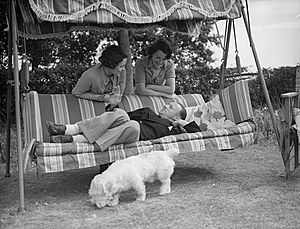
Bradman met Jessie Martha Menzies in 1920. She lived with his family to be closer to school. They married on 30 April 1932. They had a very strong and loving marriage. Jessie was a great support to him. Bradman often said he wouldn't have achieved what he did without her.
The Bradmans lived in the same house in Adelaide for most of their married life. They faced personal sadness with their children. Their first son died as a baby in 1936. Their second son, John, got polio. Their daughter, Shirley, had cerebral palsy from birth. John Bradman later changed his last name because his father's fame was a burden. But they stayed in touch.
Bradman became more private in his later years. This was partly because of his wife's health problems. Lady Bradman passed away in 1997 from cancer. This deeply affected Bradman. After his father's death, John Bradman changed his name back to Bradman. He has become the family spokesperson.
See also
 In Spanish: Don Bradman para niños
In Spanish: Don Bradman para niños
- List of Test cricket records
- ICC Player Rankings


